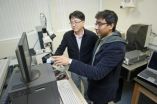(Press-News.org) Many U.S. counties have incorporated electronic voting technology, largely in response to well-publicized challenges related to older mechanical and punch-card models. Although these updated systems have solved some usability problems, they present a new set of issues for voters unfamiliar with the technology. A new study published in Human Factors examines how smartphone-based voting systems can be incorporated into the current large-scale election process.
"Current electronic voting systems have numerous issues - from usability and accessibility to security to the fact that many of them are nearing the end of their life cycle - and there are few good certified alternatives currently on the market," said Michael Byrne, professor of psychology and computer science at Rice University and one of the coauthors of "Toward More Usable Electronic Voting: Testing the Usability of a Smartphone Voting System."
Researchers Bryan Campbell, Chad Tossell, Michael Byrne, and Philip Kortum designed a mobile voting system optimized for use on a smartphone and tested its usability against traditional voting platforms. They asked 84 participants with a diverse range of voting histories and educational backgrounds to engage in a series of mock elections using different voting methods. Although the study found no reliable differences between the smartphone-based system and other voting methods in efficiency and perceived usability, smartphone owners committed fewer errors on the mobile voting system than on the traditional voting systems.
"There are numerous potential advantages [to using a smartphone-based system], said Byrne. "Nobody likes to wait in line at the polling place, and so mobile voting offers the opportunity to cast votes when and where it is convenient for the voter. However, making this work as an anywhere, anytime system requires solving a substantial number of serious security and authentication problems that may not be solvable, and certainly not in the near term."
Ongoing research is needed to develop systems that allow voters to securely and anonymously submit their ballots. "There may be compromise solutions that involve the mobile user interface that do not have the same security requirements, though they would not be as convenient," said Byrne.
INFORMATION:
To receive a copy of the article for reporting purposes, contact HFES Communications Director Lois Smith (310/394-1811; lois@hfes.org).
The Human Factors and Ergonomics Society is the world's largest nonprofit individual-member, multidisciplinary scientific association for human factors/ergonomics professionals, with more than 4,600 members globally. HFES members include psychologists and other scientists, designers, and engineers, all of whom have a common interest in designing systems and equipment to be safe and effective for the people who operate and maintain them. "Human Factors and Ergonomics: People-Friendly Design Through Science and Engineering"
Plan to attend the HFES 2014 International Annual Meeting, October 27-31, Hyatt Regency Chicago.
Smartphone-based voting technology may lead to fewer user errors
2014-02-25
ELSE PRESS RELEASES FROM THIS DATE:
New approach to chip design could yield light speed computing
2014-02-25
Every second, your computer must process billions of computational steps to produce even the simplest outputs. Imagine if every one of those steps could be made just a tiny bit more efficient. "It would save precious nanoseconds," explained Northeastern University assistant professor of physics Swastik Kar.
Kar and his colleague Yung Joon Jung, an associate professor in the Department of Mechanical and Industrial Engineering, have developed a series of novel devices that do just that. Their work was published recently in the journal Nature Photonics.
Last year, the ...
Geology covers Mars, the Moon, anthropogenic lead poisoning, earthquake hazards, and more
2014-02-25
Boulder, Colo., USA – The Geological Society of America's top journal, Geology, displays its multidisciplinary best in this latest posting. Earth science disciplines covered include geoarchaeology, climatology, invertebrate paleontology, sedimentology, geomorphology, seismology, planetary geology, geochemistry, glaciology, plate tectonics, mineralogy, and environmental and medical geology. Locations include Mars; Earth's moon; India; the Tibetan Plateau; the Saskatchewan River; L'Aquila, Italy; the Antarctic; Australia; the Andes; the San Andreas fault system; and Kume ...
Scientists twist sound with metamaterials
2014-02-25
WASHINGTON D.C. Feb. 25, 2014 -- A Chinese-U.S. research team is exploring the use of metamaterials -- artificial materials engineered to have exotic properties not found in nature -- to create devices that manipulate sound in versatile and unprecedented ways.
In the journal Applied Physics Letters, the team reports a simple design for a device, called an acoustic field rotator, which can twist wavefronts inside it so that they appear to be propagating from another direction.
"Numerous research efforts have centered on metamaterial-based devices with fascinating wave-control ...
Improvement in polymers for aviation
2014-02-25
We live surrounded by polymers and today, rather than come up with new polymers, there is a tendency to modify them in order to obtain new applications. Carbon nanotubes have excellent mechanical properties, are very tough, very rigid, and what is more, they conduct electricity. "The problem with them is that they get dispersed, in other words, it's very difficult to get them to blend with polymers," explained Iñaki Eguiazabal, a member of the Polymer Technology Group. That is why it is essential to come up with methods that will enablethe carbon nanotubes to have a ...
'Greener' aerogel technology holds potential for oil and chemical clean-up
2014-02-25
MADISON, Wis. – Cleaning up oil spills and metal contaminates in a low-impact, sustainable and inexpensive manner remains a challenge for companies and governments globally.
But a group of researchers at the University of Wisconsin–Madison is examining alternative materials that can be modified to absorb oil and chemicals without absorbing water. If further developed, the technology may offer a cheaper and "greener" method to absorb oil and heavy metals from water and other surfaces.
Shaoqin "Sarah" Gong, a researcher at the Wisconsin Institute for Discovery (WID) ...
Glycerol phenylbutyrate reduces hepatic encephalopathy events
2014-02-25
Phase 2 trial results published in the March issue of Hepatology, a journal of the American Association for the Study of Liver Diseases, suggests the potential for Glycerol Phenylbutyrate (GPB) to reduce hepatic encephalopathy episodes in patients with cirrhosis, with a safety profile similar to placebo.
Patients with hepatic encephalopathy experience neuropsychiatric symptoms that may range from mild confusion to coma. There is conflicting evidence on the link between elevated blood ammonia and hepatic encephalopathy. Poorly-absorbable disaccharides and antibiotics ...
Sensor-based irrigation systems show potential to increase greenhouse profitability
2014-02-25
COLLEGE PARK, MD--Wireless sensor-based irrigation systems can offer significant benefits to greenhouse operators. Advances in sensor technology and increased understanding of plant physiology have made it possible for greenhouse growers to use water content sensors to accurately determine irrigation timing and application rates in soilless substrates. The wireless sensor systems provide more accurate measurements of substrate moisture than qualitative methods, and can save irrigation water, labor, energy, and fertilizer. The authors of a report published in HortTechnology ...
Technique to create holes in graphene could improve water filters, desalination
2014-02-25
Researchers have devised a way of making tiny holes of controllable size in sheets of graphene, a development that could lead to ultrathin filters for improved desalination or water purification.
The team of researchers at MIT, Oak Ridge National Laboratory, and in Saudi Arabia succeeded in creating subnanoscale pores in a sheet of the one-atom-thick material, which is one of the strongest materials known. Their findings are published in the journal Nano Letters.
The concept of using graphene, perforated by nanoscale pores, as a filter in desalination has been proposed ...
Report details multiple commercial uses of wireless sensor networks
2014-02-25
ATHENS, GA--Managing the quality and quantity of freshwater resources is one of the most serious environmental challenges of the 21st century. Global population growth and increasing urbanization have resulted in increased competition for water resources among domestic, industrial, and agricultural users. Challenged to find ways to manage irrigation needs while recognizing the limitations of freshwater resources, many commercial horticulture operations are showing increased interest in the use of wireless sensor networks (WSN)--technology designed to both monitor and control ...
Analysis: 32 years of US filicide arrests
2014-02-25
PROVIDENCE, R.I. [Brown University] — Instances in which parents kill their children may seem so horrifying and tragic that they defy explanation. Published scientific and medical research, meanwhile, doesn't offer much epidemiological context to help people understand patterns among such heinous crimes. A paper in the March edition of the journal Forensic Science International provides the first comprehensive statistical analysis of filicide in the United States, drawing on 32 years of data on more than 94,000 arrests. The study also explores possible underlying psychiatric ...



